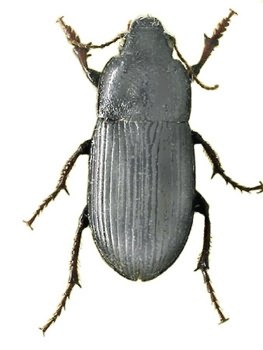Pests
Zabrus tenebrioides Goeze - Corn Ground Beetle.
Systematic position.
Class Insecta, order Coleoptera, family Carabidae, subfamily Carabinae, tribe Amarini, genus Zabrus.Synonyms.
Zabrus gibbus Fabr.Biological group.
Cereal pests.Morphology and biology.
Imago 14-16 mm in length, black with weak metallic sheen. Elytra convex, with nine strips. Pronotum with rough punctation in posterior quarter. Antennae, tibiae, and tarsi brown-red; fore tibiae dilated, with strong spine. Egg 2 mm in size, oval, white, brilliant. Larva off-white; head and three thoracic segments dark-brown; abdominal segments with light-brown dorsal spots. Pupa yellowish, with visible legs and wings, located in ground cocoon. Female fertility, 120-270 eggs. Eggs develop in 9 to 25 days depending on average daily temperature. Duration of larval damage to plants in autumn and spring depends on precipitation, reaching 15 to 105 days in autumn; harm in ring due to larval age and temperature conditions. Larvae live in the upper layer of soil, within burrows adjacent to fodder plants. At night, they leave burrows and eat wheat leaves. For diurnal feeding larvae take leaves inside their burrows. They stop feeding in November when temperatures drop to 0 - -5°C. The larvae (mainly 2nd and 3rd instars) over winter in soil on winter crops. Pupation occurs in soil at a depth of 10-20 cm at the end of April to second half of May. The pupal phase lasts 15-20 days. Beetles damage ears from the beginning of flowering to almost maturity.Distribution.
Occurs from England and Southern Sweden to Northern Africa and Minor Asia, on Cyprus; in the Ukraine, Moldova, and Transcaucasia. In Russia it is widely distributed in steppe and forest-steppe zones, northward to the Orel Region, and eastward to the Astrakhan Region bordering Kazakhstan.Ecology.
Monovoltine species. Beetles usually fly in May - June. Beetles are most active at temperatures between 20-26°C. Above 36°C, beetles perish. During summer heat and drought, beetles bury themselves into the ground to a depth of 40 cm. Dormant beetles renew activity after rains and when temperatures drop, usually in the second half of August or in the beginning of September. Factors that limit reproduction are low ground temperatures in late spring and in winter, and drought during egg hatching. Eggs do not develop at low humidity. Factors that limit distribution of the Corn Ground Beetle in areas of industrial winter wheat cultivation are climatic conditions, mainly lowering of average ground temperature to -3°C and lower, to a depth of 20 cm during the coldest month , and annual precipitation less than 400 mm.Economic significance.
The greatest damage occurs to winter wheat. Damage also occurs with other cereals: rye, barley, and less often with oat. Sometimes maize is damaged. Among the wild cereals, beetles prefer Poa sp., Eremopyrum sp., Phleum pratense, Alopecurus pratensis, and Elytrigia repens. Control measures include appropriate crop rotation (no more than two years of consecutive grain crops.); early harvest of grain crops, exclusion of grain losses, immediate and careful removal of straw from fields, stubble shelling with subsequent plowing to a depth of 20-22 cm; chemically dressing seeds, dusting and spraying crops using insecticides to control young-instar larvae.Reference citations:
Belyaev I.M. 1974. Pests of grain crops. Moscow: Kolos. 284 pp. (In Russian)Kryazheva L.P., Dolzhenko V.I. 2002. Ground Beetles and their control. St. Petersburg: VIZR. 121 pp. (In Russian)
Kryzhanovskii O.L. 1974. Family Carabidae. In: Kryzhanovskii, O.L., editor. Insects and mites-pests of agricultural plants. Coleoptera. Leningrad: Nauka. V. 2: 8-14. (In Russian)
Polyakov I.Ya., ed. 1975. Distribution of the main pests of agricultural crops in the USSR and efficiency of their control (Methodical instructions). Leningrad: VASKHNIL, VIZR. 66 pp. (In Russian)


